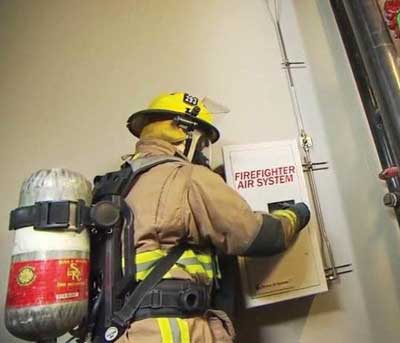By JOSEPH D. RUSH III
Imagine fighting fire in a high-rise building without a standpipe system. How much time and personnel would be wasted dragging hose? How many more large-scale tragedies would there have been? The adoption of standpipes in our building codes was a game changer for the fire service. We probably take for granted the progress the fire service has made over the years as these and other fire protection systems have become part of our standard operating procedures.
 |
| (1) Photo by Ronny J. Coleman. Click to view video |
As much progress as has been made, it is still estimated that for every one firefighter fighting high-rise fires, two are required to move equipment during the operation. At its annual conference in Atlantic City, New Jersey, in September 20143, the International Code Council (ICC) presented the fire service with another potential game-changer with the adoption of the firefighter air replenishment systems (FARS) into Appendix L of the 2015 IFC.
FARS offers an opportunity for increased operational efficiency as well as greater firefighter and occupant safety. The mechanics of FARS are relatively simple, using technology and equipment already in use within the fire service. Integrated into the building’s infrastructure, it has been described as a “standpipe for air.” The six principal components consist of an exterior mobile air connection (EMAC), air storage system, interior air fill station, piping distribution system, system isolation valves, and air-monitoring system. Although the IFC code standardizes the installation, certain aspects of FARS designs may vary in accordance with the local jurisdiction’s policies and procedures and operational needs and preferences.
The EMAC enables a fire department’s mobile air unit to attach to FARS. The mobile air unit can provide breathing air directly into FARS or supplement its air-storage system. The piping distribution system safely delivers breathing air to all the FARS components. It is cross-connected and equipped with system isolation valves to ensure its operations are sustained even if the building is damaged. The system isolation valves can be operated manually at each fill station or remotely from the building’s fire command center.
This air-monitoring system provides 24/7 real-time monitoring of air pressure, carbon monoxide, carbon dioxide, nitrogen, oxygen, moisture, and hydrocarbon levels. If readings exceed minimum expected levels, FARS flashes red lights. The signal is also transmitted to the fire command center or an independent monitoring station.
Two variations of the interior air-fill station give fire departments the option of refilling self-contained breathing apparatus (SCBA) in rupture containment stations or at emergency air-fill panels that use the SCBA’s rapid intervention crew (RIC) universal air connection (RIC/UAC) fitting. Rupture containment stations are strategically located in secure areas on predetermined floors. SCBAs are filled and rotated in the traditional manner. The emergency air-fill panels are typically located in or adjacent to stair towers, on every other floor. This process allows at least two SCBAs to be refilled simultaneously and can be performed in contaminated atmospheres.
The First Interstate Bank fire in Los Angeles, California, in 1988 and the One Meridian Plaza fire in Philadelphia, Pennsylvania, in 1991 illustrate this point. At both incidents, large portions of support operations were dedicated to the refilling and shuttling of SCBAs. Tragically, three firefighters perished at One Meridian Plaza when they became disoriented and exhausted their air supply on the 28th floor. Another eight firefighters narrowly escaped death on the 38th floor while trying to exit to the roof. In similar scenarios, a readily available supply of air within close proximity to the fire would result in more efficient fireground operations and increased firefighter and occupant safety.
Prior to the ICC’s adoption of Appendix L into the IFC, FARS had been installed in more than 300 buildings throughout Arizona, California, Colorado, Florida, Nevada, and Oregon. However, the local adoption processes varied and the individual codes differed. Appendix L now provides uniformity in a consistent guideline for installation in all jurisdictions that choose to adopt it.
We tend to lose sight of the fact that high-rise fires are not exclusive to metropolitan areas; large fire departments have a seamlessly unlimited supply of resources to overcome almost any obstacle. Although Appendix L has clear value in this area, it could prove to have its greatest impact in communities serviced by smaller paid fire departments or the volunteer services. Bringing an air supply closer to the work area will facilitate fire operations for fire departments that have limited resources and often lack the luxury of any support services.
It is very likely that we will see FARS technology in more than just high-rises. FARS is already being installed in tunnels and mega-structures, and its practical application makes it a likely candidate for maritime installation as well.
The 2015 IFC and Significant Changes to the IFC have been available as of June 2, 2014.
JOSEPH D. RUSH III, MS, EFO, retired as a battalion chief after 25 years with the Atlantic City (NJ) Fire Department. He is an instructor at the Atlantic County (NJ) Fire Academy.
Fire Engineering Archives

